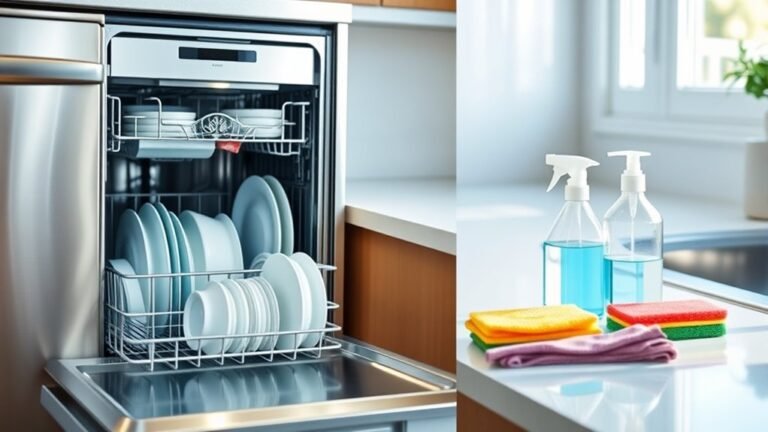How to Clean and Maintain Your Fireplace
You should start by removing ashes with a sturdy brush and vacuuming fine particles using a HEPA-filter vacuum. For wood fireplaces, clean the firebox and check the chimney for blockages or creosote buildup. Gas fireplaces need burner and pilot light inspections, while pellet units require regular ash pan cleaning. Don’t forget to inspect the chimney’s condition and keep vents clear. Keeping up with these steps guarantees safety and efficiency—there’s plenty more to explore about maintaining your fireplace’s best performance.
Tools and Materials Needed for Fireplace Cleaning

To clean your fireplace effectively, you’ll need a few essential tools and materials on hand. First, gather your basic fireplace tools: a sturdy brush, a metal shovel, and a fireplace poker to safely handle ashes and debris. Next, have a dustpan ready to collect soot without making a mess. For cleaning materials, you’ll want a strong vacuum with a HEPA filter to capture fine ash particles, along with a mild detergent or specialized fireplace cleaner to tackle stubborn grime. Don’t forget rubber gloves and safety goggles to protect yourself while working. Having these fireplace tools and cleaning materials within reach guarantees you maintain your fireplace efficiently, giving you the freedom to enjoy a warm, cozy fire without hassle or worry about mess or damage.
Step-by-Step Guide to Cleaning a Wood-Burning Fireplace
Cleaning your wood-burning fireplace involves several key steps that guarantee safety and efficiency. First, remove ashes and debris to prevent buildup. Next, inspect the firebox and chimney for damage or blockages, confirming fireplace safety. Finally, clean the glass doors and surrounding surfaces. Remember, your cleaning frequency depends on usage—monthly checks during heavy use, and biannual deep cleans are ideal.
| Step | Action | Purpose |
|---|---|---|
| 1 | Remove ashes | Prevents clogging |
| 2 | Inspect chimney | Confirms safety |
| 3 | Clean glass & surfaces | Maintains appearance |
Maintaining Gas Fireplaces for Safety and Efficiency

While wood-burning fireplaces need regular ash removal and chimney inspections, gas fireplaces require a different approach to keep them running safely and efficiently. For your freedom to enjoy warmth without hassle, gas fireplace maintenance focuses on checking gas lines for leaks, cleaning burners, and inspecting pilot lights. You’ll want to schedule annual safety inspections to verify everything’s in top shape, preventing carbon monoxide risks and ensuring efficient operation. Don’t forget to clean the glass front and remove dust from vents to maintain clear airflow. By handling these tasks or hiring a professional, you’re safeguarding your home while enjoying the convenience and clean heat gas fireplaces offer. Staying on top of these steps gives you peace of mind and keeps your fireplace ready whenever you want it.
Tips for Cleaning Pellet Fireplaces
Since pellet fireplaces burn compressed wood pellets, they require regular cleaning to keep them operating efficiently and safely. Proper pellet stove maintenance means removing ash and checking components frequently. You’ll want to follow these ash disposal tips to avoid mess and fire hazards.
| Task | Frequency |
|---|---|
| Empty ash pan | Weekly |
| Clean burn pot | Every 2 weeks |
| Vacuum interior | Monthly |
| Inspect gaskets | Every 3 months |
| Check vent pipes | Annually |
How to Inspect and Maintain Your Chimney

Keeping your pellet fireplace in top shape means you can’t overlook the chimney. Regular chimney inspection is essential to guarantee safety and efficiency. You’ll want to check for cracks, blockages, or creosote buildup that can restrict airflow or pose fire hazards. Use a flashlight to peer inside, or better yet, hire a professional for a thorough inspection. For effective chimney maintenance, keep the exterior clear of debris and make sure the chimney cap is intact to prevent animals and rain from entering. Don’t forget to clean the flue regularly to maintain proper ventilation. Staying on top of these tasks gives you the freedom to enjoy your fireplace without worry, keeping your home safe and warm all year long.
Seasonal Maintenance Checklist for Your Fireplace
A solid seasonal maintenance checklist can help you catch potential issues before they become costly problems. Start by scheduling thorough seasonal inspections of your fireplace and chimney to guarantee everything’s in top shape. Check for cracks, creosote buildup, or blockages that could compromise fireplace safety. Clean the firebox and remove ashes regularly to keep airflow smooth and prevent hazards. Inspect and test damper operation to confirm it seals properly when closed. Don’t forget to examine the fireplace screen or glass doors for damage. Finally, verify your smoke and carbon monoxide detectors are functional before the cold season sets in. By following this checklist, you’ll enjoy the warmth and freedom of your fireplace with confidence and peace of mind all year long.
Frequently Asked Questions
Can I Use a Fireplace Year-Round Without Damage?
You can use your fireplace year-round, but you’ve got to keep fireplace safety in mind. Continuous use without proper care might lead to wear or creosote buildup, increasing fire risk. If you want the freedom to enjoy cozy flames anytime, make sure to inspect and maintain it regularly. Ventilation and cleaning are key to avoiding damage, so you can safely enjoy your fireplace all year long without worries.
What Are the Signs of a Dangerous Chimney Blockage?
You’ll want to watch for blockage symptoms like smoke backing up into your home, a strong soot smell, or poor draft when you light a fire. These signs mean it’s time for a thorough chimney inspection. Ignoring them can trap dangerous gases or cause fires. Staying free means staying safe—regular checks keep your chimney clear and your home secure, so you can enjoy your fireplace without worry.
How Often Should I Replace Fireplace Tools?
You probably want your fireplace tools to last forever, right? Well, in reality, fireplace tool longevity depends mostly on the tool material quality and how often you use them. If they’re made from sturdy steel or wrought iron, you might not need to replace them for years. But if they start rusting or bending, it’s time to set them free and get new ones. Keep your tools strong, and you’ll enjoy your fireplace without hassle!
Is It Safe to Burn Artificial Logs or Fire Starters?
When thinking about artificial logs safety, you’ll want to choose those made from natural materials without harmful chemicals to avoid toxic fumes. Some fire starter types, like wax-based or natural kindling, burn cleaner and are safer for your fireplace and air quality. Always check product labels and verify good ventilation. Using the right products lets you enjoy your fire freely and safely without compromising your health or your home’s environment.
What Are the Benefits of Using a Fireplace Insert?
If you want to boost your home’s warmth without cranking up the heat, a fireplace insert’s perfect. It improves energy efficiency by sealing in heat better than an open hearth, meaning you’ll use less fuel and save money. Plus, it offers superior heat retention, so your space stays cozy longer. You’ll enjoy the freedom of a cleaner, safer fire experience while still basking in that classic fireplace charm.






